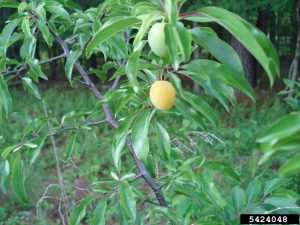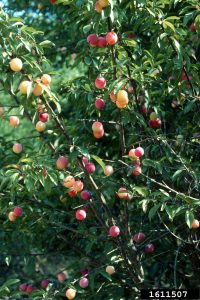Chickasaw Plum, Prunus angustifolia

Photo by Chris Evans, University of Illinois, Bugwood.org

Photo by Franklin Bonner, USFS (ret.), Bugwood.org

Photo by John Ruter, University of Georgia, Bugwood.org
Height: 8 to 20 feet
Spread: 8 to 12 feet
LANDSCAPE USE
Performs best in naturalistic settings or where large, dense shrubbery is required. Good for soil stabilization and roadside beautification.
FORM
An erect, much-branched, deciduous, colonizing, usually multi-stemmed shrub or very small tree with a showy display of spring flowers. Often forming dense thickets due to suckering from shoots and underground stems.
NATIVE RANGE
Woodland edges, dry hammocks, disturbed roadsides, fencerows, and open fields. Delaware, southward to central Florida, and west to Texas.
CHARACTERISTICS
Flowers: White, small, 5-petaled, borne profusely and making a showy display. Spring.
Leaves: Alternate, lance shaped, 1-3 inches long, often reflexed upward from the midrib, shiny green above, with minute teeth along the margins.
Fruit: A round, ½- to 1¼-inch-long, red to yellow drupe with a whitish glaze.
Bark: Reddish brown; furrowed, somewhat scaly with age.
CULTURE
Soil: Occurs naturally in dry to moist, sandy soil with pH 5.0-7.5. Mildly salt tolerant.
Exposure: Full sun.
Water: Performs well in well-drained situations. Supplemental irrigation not required.
Hardiness Zones: 5 to 9.
Life Span: Moderately fast growing and short lived; probably less than 50 years.
BEST FEATURES including WILDLIFE SUPPORT
Profuse and showy spring flowering season and attractive fruit. Good for wildlife cover and food. It is a larval host for Tiger Swallowtail butterflies, Hairstreaks and many moth species, all of which are in turn food for migrating birds. It’s also a host for ladybugs. May attract web worms but as noted above, these are also important bird food and not harmul, just unattractive. Suckering habit makes this plum useful for soil stabilization.
COMPANION PLANTS
Beautyberry (Callicarpa americana), Pignut Hickory (Carya glabra), Redbud (Cercis canadensis), Southern Crabapple (Malus angustifolia), Sweetgum (Liquidambar styraciflua), Bluestems and Broomsedges (Andropogon spp.), Cherokee Bean (Erythrina herbacea), Adam’s Needle (Yucca filamentosa), Wax Myrtle (Myrica cerifera).
DISADVANTAGES
Suckering habit can sometimes be difficult to control. Webworms are attracted to this species but are an extremely important food source for migrating birds and do not harm the trees, especially as they are going dormant anyway.
ALLERGENIC AND TOXIC PROPERTIES
Caution is advised. Some species in this genus are known to cause cyanide poisoning and can be lethal in large quantities. Ingestion of smaller amounts may cause a variety of debilitating symptoms.
SIMILAR AND RELATED SPECIES
Several related species occur naturally in Florida. Hog or flatwood plum (P. umbellata) is similar but has purplish fruit, has a single trunk, and does not form dense colonies. American plum (P. americana) is a tree with reddish brown to tan, shaggy bark, an upright stature, and slightly larger flowers.